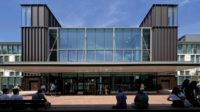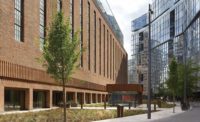Repurposing tough, idiosyncratic industrial structures just got more extreme. In London’s 67-acre King’s Cross regeneration area, the architects WilkinsonEyre have transformed a set of Victorian gasholders with exposed iron frames—a peculiarly British infrastructure type—into 145 upscale apartments.
Clearly modern silvery cylindrical buildings now fill the spaces within the frames. But they were once occupied by huge telescoping cylindrical metal gas reservoir tanks (called “bells”) that floated on belowground cisterns of water, rising and falling on guide rails. The new volumes within the salvaged frames are designed, in their varying heights and aluminum cladding, to recall these vanished tanks.
Additional Content:
Jump to credits & specifications
The containers stored gas produced from coal, known in the UK as “town gas” and used for street lighting, industrial processes, cooking stoves, and furnaces. Seldom encased within buildings, as was more common in the United States and Europe, they were once landmark features of most British towns and cities. Relatively few survive, since manufactured town gas gave way to pressurized natural gas in the 1970s.
The town-gas plant here—which was built and extended between 1860 and 1880, in the industrial zone behind the neighboring Victorian railroad terminuses of Kings Cross and St. Pancras—was dismantled in 2001 to make way for a new high-speed rail link to France. But, by then, these interlinked post-and-beam iron frames, with their simplified Neoclassical details, had achieved official “listed” (landmarked) status. WilkinsonEyre won the competition to reuse them in 2002, and the development consortium for the site carefully restored the iron frames, earmarking a new spot to re-erect them a few hundred yards to the north, on the banks of another industrial relic, the Regent’s Canal.
The frames then became the armature for a trio of freestanding apartment buildings in cylindrical drums of different heights. Practice founder Chris Wilkinson explains that such aged cast-iron components—originally carrying no weight, because the gas bells within them were self-supporting—could not be called upon to bear the loads of modern buildings. Accordingly, the frames—now painted battleship gray—stand slightly proud of the three new drums, giving clearance for motorized perforated-aluminum shutters on the apartments to open. In total, the conserved structure consists of an interlinked set of four gasholder frames, the fourth enclosing a small park designed by architects Bell Phillips.
Wilkinson, who has his own three-bedroom apartment in the complex, developed a scheme of intersecting circles that resembles the gears of a watch. By removing a pie-slice-shaped piece from each of the three new cylindrical volumes, he avoided having them touch or block light and views in any of the apartments. He designed circular atria for the center of the drums, enlivened by “scallops”—balconies that widen at different points to create the sense of spiraling, upward movement. And at the hub of the complex, where the three frames meet, is a circular courtyard, left open to the sky and landscaped with a shallow water feature at its base. This new space is energized by the iron columns and latticework beams of the conserved—and now celebrated—original structure.
The walls encircling the central courtyard are clad in precast concrete panels, pale gray with fine vertical ribbing, relieved by walkways slung off the wall to connect the blocks on three levels. These contrast with outward-facing elevations that are covered in silver-gray aluminum, with the perforated shutters continuing across openings for windows and balconies. To complete the allusion to the old telescoping gas bells, the exterior skin is divided into horizontal bands by dark-painted steel ring beams. Landscaped roof gardens occupy the top of each cylinder.
Within the buildings, the common areas have floors and stairs in smooth concrete, with delicate radial brass strips that were inspired by Wilkinson’s watchwork model and emphasize the circular geometry. The apartment interiors, by Jonathan Tuckey Design, are highly crafted with much use of sliding room dividers in mid-brown stained wood. Since each apartment is wedge-shaped, the emphasis is naturally on the views out, and the plan of the apartments incorporates the gentle curve.
Gasholders has the expected amenities for such developments, including a business center, a gym and spa, and rooms that residents can book for large-scale entertaining. Overall, however, the project is anything but conventional. And that derives largely from the geometry and expressive character of the preserved original structure, along with a thoroughly appreciative architectural response.
CreditsArchitect: WilkinsonEyre 33 Bowling Green Ln, Clerkenwell, London EC1R 0BJ
Personnel in architect's firm who should receive special credit: Chris Wilkinson, Gary Clark, Jeff Lee, Elliott Krause, Dominic Wilkinson, Danielle Purcell, Louise Cann, Niels Thuesen, Sevil Pius
Interior architect for the apartments: Jonathan Tuckey Design
Engineers Structural and Façade: Arup Environmental/Sustainability/Services: Hoare Lea
Consultants Landscape architect: Dan Pearson Studio Lighting: Speirs & Major Quantity Surveyor: Gardiner & Theobald Frames restoration: Shepley Engineers
General contractor: Carillion
Photographer: Peter Landers |
SpecificationsStructural System Manufacturer of any structural components unique to this project: Reinforced concrete frame throughout, original gasholder frames made of cast iron. Restored by Shepley Engineers Radial pin connected steel bridge to courtyard with curved glass balustrading. Manufactured by Frener Reifer.
Exterior Cladding to courtyard ‘Ductal by LaFarge’ ultra-high strength precast concrete cladding to the courtyard. Manufactured by Thorp Precast
Exterior Cladding Metal/glass curtain wall: Unitised façade with a perforated aluminum rainscreen and motorised sliding folding shutter system externally fixed. Manufactured by Frener Reifer.
Roofing Built-up roofing: American Hydrotech Inverted Roofing System by Alumasc
Windows Metal frame: Schueco Triple Glazed Aluminium Windows Installed by Frener Reifer.
Glazing Skylights: Double glazed stick system laid onto steel beams to falls with ‘butterfly’ configured motorised glazed smoke vents. Manufactured by Frener Reifer.
Doors Sliding doors: Schueco Triple Glazed Aluminium Doors installed and engineered by Frener Reifer
Hardware Other special hardware: Bespoke Brass Main Entrance door handles designed by Chris Wilkinson and manufactured by Franchi Bespoke brass mailboxes, The Safety Letterbox Company
Interior Finishes Ironmongery internals, including bespoke brass apartment door handles: Franchi Floor and wall tile: Domus tiles to apartment toilets and bathrooms, installed by EE Smith, Natural Marble Stone tiles to Spa and large format panels to apartment bathrooms installed by EE Smith UK Resilient flooring: Resin Flooring within apartments by Senso UK, Resin stone flooring to common parts by Avant Garde UK |














Post a comment to this article
Report Abusive Comment